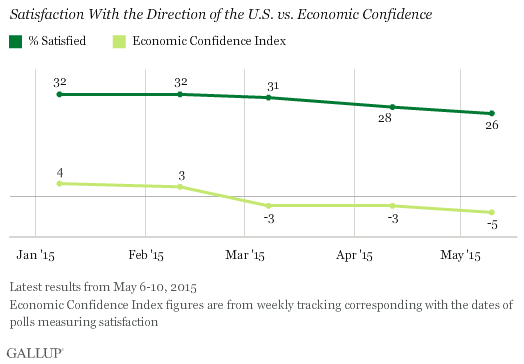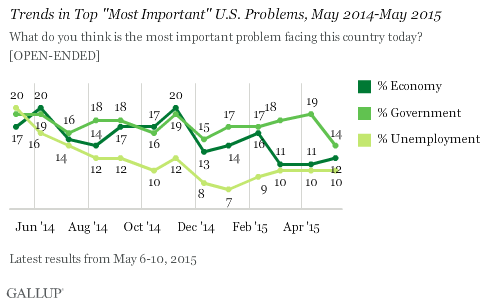Story Highlights
- One in four Americans (26%) satisfied with direction of U.S.
- Satisfaction down six points since February
- Gov't, economy and unemployment remain most cited U.S. problems
WASHINGTON, D.C. -- After reaching a more than two-year high in early 2015, Americans' satisfaction with the direction of the U.S. continues to fall. Twenty-six percent of Americans say they are satisfied with the way things are going in the nation in May, down slightly from 32% in January and February.

The latest data are from Gallup's May 6-10 poll.
Satisfaction jumped nine points in January to 32%, a promising sign that Americans' moods were improving after a year of lower figures throughout 2014, ranging between 20% and 27%. Since February, though, satisfaction has dipped only slightly each month, but these small drops have resulted in a six-point decline since the beginning of the year. Satisfaction remains below the 36% historical average for Gallup's trend dating back to 1979.
The drop in Americans' satisfaction with the way things are going parallels the recent decline in economic confidence. Americans had a more positive outlook on the economy at the dawn of 2015, but these views, like satisfaction, have edged down in recent months.

Views of the nation's direction have certainly been brighter in the past. Majorities of Americans were typically satisfied with the direction of the U.S. between 1998 and mid-2002 -- including a record high of 71% in February 1999. But satisfaction declined steadily in the latter half of President George W. Bush's presidency as the public grew disillusioned with the war in Iraq and the national economy suffered. This dip in satisfaction culminated in 7% of Americans, a record low, saying they were satisfied with the direction of the nation in October 2008 as the global economy collapsed and the U.S. stock market plummeted.
Satisfaction improved significantly during the first year of President Barack Obama's term -- reaching 36% in August 2009. It has not returned to that level since, ranging between 11% and 33% throughout Obama's time in office.
Americans Still List Economy, Gov't and Unemployment as Top Problems
Though the 14% of Americans who name dissatisfaction with government, Congress and politicians as the top problem facing the U.S. has fallen five points since April, it still remains the most commonly mentioned problem -- a distinction it has held for six months.
The economy in general (12%) and unemployment (10%) have remained at the top of the list for several years. But mentions of these issues are down significantly from their recent peaks -- the economy reached a high of 37% in 2012, and unemployment reached a high of 39% in 2011.

Race relations and racism (8%), immigration (6%), a decline in moral, religious and family ethics (6%), the state of the healthcare system (5%) and terrorism (5%) were also among the most frequently cited problems facing the nation.

Bottom Line
After years of dysfunctional government, the economy and unemployment dominating Americans' mentions of the top problem facing the nation, fewer mention these problems now than in recent years. Still, these three problems remain at the forefront of Americans' concerns, and may be driving Americans' high level of dissatisfaction with the nation's direction.
Although Americans' confidence in the economy is higher this year than in recent years, it is still negative. And while fewer mention dysfunctional government as the nation's top problem, Americans still strongly disapprove of Congress' performance and remain divided on Obama's.
Meanwhile, mentions of unemployment as a top problem have dipped as more U.S. workers report their workplaces are hiring and the unemployment rate as reported by the BLS declines. But unemployment still remains one of the most frequently cited problems.
Survey Methods
Results for this Gallup poll are based on telephone interviews conducted May 6-10, 2015, with a random sample of 1,024 adults, aged 18 and older, living in all 50 U.S. states and the District of Columbia. For results based on the total sample of national adults, the margin of sampling error is ±4 percentage points at the 95% confidence level. All reported margins of sampling error include computed design effects for weighting.
Each sample of national adults includes a minimum quota of 50% cellphone respondents and 50% landline respondents, with additional minimum quotas by time zone within region. Landline and cellular telephone numbers are selected using random-digit-dial methods.
Learn more about how Gallup Poll Social Series works.

